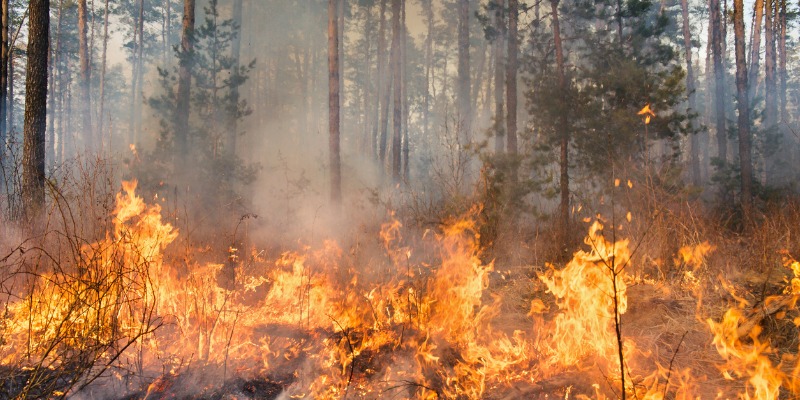Canada’s burning because of bad forest policy, not climate change

Unless you’ve been living in an underground cave, you’re aware that there’s been a massive explosion of forest fire activity across Canada that’s sending clouds of smoke south to our American neighbours. Not surprisingly, they’re not happy—the orange skies are more than a bit reminiscent of Hollywood post-apocalyptic movies.
Here at home, our usual opportunistic climate alarmists including Prime Minister Trudeau, Environment Minister Guilbeault and the irrepressible Elizabeth May blame the flames on climate change (and not their leadership in Canadian forest policy). And the only cure is to end fossil fuel use.
But let’s bring some facts to the hysteria. First, the climate is indeed warming. According to the United Nations Intergovernmental Panel on Climate Change (IPCC), the global average atmospheric temperature is rising globally, and according to one analysis, twice as fast in Canada. (Of course, how much of this warming is human-driven is a different story.)
But is this recent atmospheric warming causing the increase in forest fires globally and Canadian fires specifically? The IPCC, in its latest omnibus climate report, only assigns “medium confidence” to the idea that climate change has actually caused increased “fire weather” in some regions on Earth. This, mind you, after desperately seeking to tie real-world events to increasing greenhouse gas concentrations for some 40 years now. In addition, many reports have shown that while fire activity is on the rise in some regions, we’re still not seeing an overall increase when considering the total areas burned at the global level.
As the Royal Society, an independent scientific academy in the United Kingdom, summarizes in a 2020 blog post updating its 2016 research on global wildfire extent, "Fire activity is on the rise in some regions, but when considering the total area burned at the ground level, we are not seeing an increase an overall increase.” The 2016 report was more explicit, finding: “Instead, global area burned appears to have overall declined over past decades, and there is increasing evidence that there is less fire in the global landscape today than centuries ago.” While the Royal Society acknowledges that climate change may be increasing risk, it also observes there are many other human activities that may contribute to more or less fires, and more or less areas consumed.
But what about Canada per se? Is it clear that Canada’s fire issues are climate-driven? Unless one believes that inverse correlations suggest causality, the answer is no. That’s according to a 2020 study in the journal Progress in Disaster Science where authors Tymstra et al. show a fairly sharp declining trend in the number of fires (annually) over time, and a mixed record of areas burned, though the authors note an apparent increase in areas burned over the last two decades.
In fact, as average atmospheric temperatures have risen from 1970 to 2017, Canadian forest fires have declined sharply in number and show little obvious trend in areas burnt.
Crucially, Tymstra’s study also finds that wildfire management policy in Canada comes up short. “A major barrier in Canada… is the inadequate funding to support the vision of an innovative and integrated approach to wildfire management. Mitigation funding has followed wildfire disasters but not at the same level to mitigate flood and earthquake disasters. Despite the increasing occurrence of wildfire disasters in Canada, funding to support wildfire prevention, mitigation and preparedness have not kept pace with the increasing need to mitigate the impacts from wildfires, and be better prepared when they do arrive.”
More specifically, Tymstra et al. find that Canada has failed to fund the proactive management of forest fires sufficiently and is not poised to do better moving forward. “Wildfire management agencies in Canada are at a tipping point. Presuppression [sic] and suppression costs are increasing but program budgets are not.” But clearly, a lack of fire suppression is also a problem: “Wildfire suppression contributes to a wildfire problem but paradoxically it is wildfire use that will help to solve this problem. The wildfire management toolbox must include wildfire use to manage wildfires at the landscape scale because it is not feasible to effectively use prescribed burns and/or fuel management treatments alone to restore expansive wildfire-dependent ecosystems.” That’s a somewhat academic long-winded way of saying you need to fight fire with fire, but the point is valid nonetheless.
Canada is having a hell of a fire season, there’s no disputing that. And it’s producing hellish landscapes across Canada and North America. What it is not, however, is a call to more of the same old “climate action.” But rather, a call for more sane real-world real-time management of fire risk in Canada’s forests, a practise that Canadian governments have failed at for decades.
One can only hope that this fire season will light a fire under Canada’s fire-foolish policymakers, and finally motivate them to take the rational course—fighting fire risk with fire use, rather than pointing to the climate sky gods and calling for appeasement measures that will not affect Canada’s risk of forest fires.
Author:
Subscribe to the Fraser Institute
Get the latest news from the Fraser Institute on the latest research studies, news and events.

